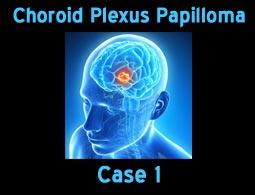Choroid Plexus Papilloma (CPP): Overview
- Together with Teratoma, PNET, and High Grade Glioma is one of the most common brain tumors before age of two years.
- It comprises less than 1% of brain tumors.
- These are typically located in the lateral ventricle (50%), or in the fourth ventricle (40% and more commonly in adults), in the third ventricle (10%), and rarely in the cerebellopontine angle (CPA). They are rarely bilateral (4%).
- They are typically well circumscribed, vascular, and contrast enhancing.
- Patients typically present with hydrocephalus as a result of increased cerebrospinal fluid (CSF) production, or due to blockage of CSF flow from direct obstruction of hemorrhage.
- Surgical resection usually has a good outcome with rare recurrences.
- There are rare malignant transformations.
- As with intraventricular meningiomas, they are more frequently on the left intraventricular space.
- This tumor needs to be differentiated from choroid plexus carcinoma (CPC) which has 15% incidence of CPPs. CPCs usually invade the parenchyma of brain and seed the CSF. Treatment of CPC is with surgery and radiation with or without chemotherapy with poor prognosis.
Choroid Plexus Papilloma (CPP) Cases:



















